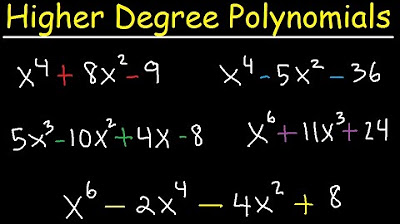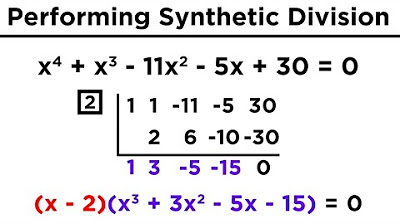Factoring Cubic Polynomials- Algebra 2 & Precalculus
TLDRThis video tutorial delves into the process of factoring cubic polynomials, starting with the method of factoring by grouping, which involves identifying common ratios among coefficients. The script demonstrates this technique with several examples, showing how to extract common factors and simplify expressions. It also covers the use of synthetic division to find rational zeros and further factorize the polynomials. The video emphasizes the importance of checking for possible rational zeros and provides a step-by-step guide to solving cubic equations, ensuring viewers grasp the fundamental concepts of polynomial factorization.
Takeaways
- 📚 The video focuses on factoring cubic polynomials using specific methods.
- 🔍 Factoring by grouping is a method that can be used if the coefficients of the polynomial have a common ratio.
- ✂️ To factor by grouping, first identify the greatest common factor (GCF) for both the first two and last two terms of the polynomial.
- 🔢 The first example shows how to factor x^3 + 2x^2 - 5x - 10 by grouping, resulting in (x + 2)(x - 5).
- 📉 The second example demonstrates factoring 4x^3 - 8x^2 + 6x - 12 by taking out common factors and simplifying to 2(x - 2)(x + 3).
- 🔄 The third example involves using the GCF and difference of squares to factor x^3 + 3x^2 - 4x - 12 into (x + 3)(x + 2)(x - 2).
- 🚫 If factoring by grouping is not possible, due to coefficients not having a common ratio, consider using the possible rational zeros method.
- 🔎 The possible rational zeros are the factors of the constant term divided by the factors of the leading coefficient.
- 📝 Synthetic division is used to test possible zeros and to reduce the polynomial once a zero is found.
- 🔄 The process of synthetic division involves bringing down the leading coefficient, multiplying, adding, and repeating until a zero is obtained.
- 📉 The final example shows how to factor a cubic polynomial that does not lend itself to grouping, resulting in (x - 2)(x + 1)(x - 3) after finding a zero and reducing the polynomial.
- 👍 The video concludes with the advice to always try factoring by grouping first, and if not possible, use synthetic division to find rational zeros and factor the polynomial.
Q & A
What is the main topic of the video?
-The main topic of the video is factoring cubic polynomials.
What is the first method discussed in the video for factoring cubic polynomials?
-The first method discussed is factoring by grouping.
How does the video suggest determining if factoring by grouping can be used?
-The video suggests checking if the first two coefficients have the same ratio as the last two coefficients.
What is the greatest common factor (GCF) extracted from the first two terms of the first example in the video?
-The greatest common factor extracted from the first two terms of the first example is x squared.
In the first example, what is the GCF of the last two terms?
-In the first example, the GCF of the last two terms is negative five.
What is the final factored form of the first cubic polynomial example given in the video?
-The final factored form of the first example is (x + 2)(x^2 - 5).
What is the greatest common factor for the first two terms in the second example provided in the video?
-The greatest common factor for the first two terms in the second example is 4x squared.
How does the video demonstrate finding the factors of the cubic polynomial x^3 + 3x^2 - 4x - 12?
-The video uses the method of factoring by grouping and then applies the difference of squares technique to factor the remaining quadratic expression.
What is the process used to find possible rational zeros of a cubic polynomial when factoring by grouping is not applicable?
-The process involves finding the factors of the constant term and dividing them by the factors of the leading coefficient to determine possible rational zeros.
How does the video demonstrate the use of synthetic division to reduce a cubic polynomial?
-The video uses synthetic division by plugging in a found rational zero, like x = 2, and dividing the polynomial to get a quadratic expression.
What is the final factored form of the cubic polynomial given in the last example of the video?
-The final factored form of the last example is (x - 2)(x + 1)(x - 3).
What is the advice given by the video for approaching the factoring of cubic polynomials?
-The advice given is to first try factoring by grouping, and if that's not possible, then use the synthetic division method to find rational zeros and factor the polynomial.
Outlines
📚 Introduction to Factoring Cubic Polynomials
This paragraph introduces the topic of the video, which is factoring cubic polynomials. The presenter begins by examining the expression x^3 + 2x^2 - 5x - 10 and suggests using the factoring by grouping method due to the common ratio in the coefficients. The greatest common factor (GCF) is identified for each pair of terms, and the process of factoring out the GCFs is demonstrated, leading to the factored form of the polynomial. The paragraph also introduces another example, 4x^3 - 8x^2 + 6x - 12, and guides the viewer through the factoring process, emphasizing the importance of identifying even numbers to simplify the expression further.
🔍 Factoring with Synthetic Division and Rational Zeros
The second paragraph delves into the process of using synthetic division to find rational zeros of a cubic polynomial. The example polynomial x^3 + 3x^2 - 4x - 12 is used to illustrate this method. The presenter explains how to determine the possible rational zeros by considering the factors of the constant term and the leading coefficient. The synthetic division process is demonstrated with the number 2, which is identified as a zero of the polynomial. The resulting quadratic is then factored further, and the presenter acknowledges a mistake in the previous synthetic division, correcting it with the number -1 and showing that it also results in a zero. The paragraph concludes with the complete factorization of the cubic polynomial into linear factors.
📘 Conclusion and Final Thoughts on Factoring Cubic Polynomials
In the concluding paragraph, the presenter summarizes the key points of the video. They emphasize the importance of first attempting to factor by grouping and then, if that is not possible, using synthetic division to find rational zeros. The presenter thanks the viewers for watching and encourages them to apply these methods to practice factoring cubic polynomials effectively. The paragraph leaves the viewers with a clear understanding of the steps involved in factoring cubic polynomials and the tools available to solve them.
Mindmap
Keywords
💡Factoring
💡Cubic Polynomials
💡Factoring by Grouping
💡Greatest Common Factor (GCF)
💡Synthetic Division
💡Rational Zeros
💡Difference of Squares
💡Polynomial Roots
💡Trinomial
💡Quadratic Expression
Highlights
Introduction to the method of factoring cubic polynomials.
Explanation of factoring by grouping using the example of x^3 + 2x^2 - 5x - 10.
Identification of the greatest common factor (GCF) in the first two terms of the polynomial.
Identification of the GCF in the last two terms and the factoring process.
Factoring out x + 2 from the given polynomial example.
Demonstration of the factoring process with another example: 4x^3 - 8x^2 + 6x - 12.
Using GCF to simplify the polynomial and reveal the pattern x - 2.
Further simplification by factoring out 2 from the remaining terms.
Practice problem presented: x^3 + 3x^2 - 4x - 12.
Application of factoring by grouping to the practice problem with a ratio analysis.
Use of the difference of squares technique to factor x^2 - 4.
Final factorization of the practice problem into (x + 3)(x + 2)(x - 2).
Introduction of an example where factoring by grouping is not applicable.
Explanation of finding possible rational zeros of a function.
Demonstration of synthetic division to reduce the polynomial.
Identification of x = 2 as a solution and factoring the cubic polynomial.
Further factorization of the resulting trinomial x^2 - 2x - 3.
Correction of a potential oversight in synthetic division with x = -1.
Final summary of the video's educational content on factoring cubic polynomials.
Transcripts
Browse More Related Video

Solving Polynomial Equations By Factoring and Using Synthetic Division

Finding All Zeros of a Polynomial Function Using The Rational Zero Theorem

How to Use the Rational Zeros Theorem (Precalculus - College Algebra 34)

Finding ALL Solutions of Polynomials (Precalculus - College Algebra 37)

Factoring Higher Degree Polynomial Functions & Equations - Algebra 2

Solving Higher-Degree Polynomials by Synthetic Division and the Rational Roots Test
5.0 / 5 (0 votes)
Thanks for rating: